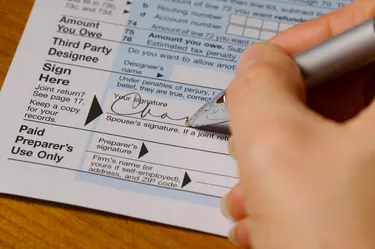
If you're on permanent or temporary disability from your job, you can refinance your existing mortgage loan to take advantage of lower rates or better repayment terms. You have two options: If your monthly income with your disability payments is enough to cover your total monthly debt and the new mortgage payment -- totaling less than 36 percent of your monthly income -- you qualify for a standard refinance. If not, you can ask your mortgage lender for a loan modification to lower your interest rate or change other mortgage terms, also resulting in lower monthly payments.
Step 1
Find the financial paperwork that you'll need to send to your mortgage lender to begin the refinance process. This includes a copy of your mortgage statement, copies of your two most recent disability payments, copies of your two most recent federal income tax returns, copies of your credit-card bills, and copies of statements from any other loans, such as student or car loans.
Video of the Day
Step 2
Call your mortgage lender at the number listed on your current mortgage statement. Explain that you are on disability but that you'd like to refinance your mortgage loan. If you're having trouble making your mortgage payments because your income has dropped, tell your lender.
Step 3
Give your lender permission to run a credit check. This will produce your three-digit credit score. Lenders rely on credit scores to determine if a borrower is a risky bet or a safe one. Borrowers with scores of 720 or above generally qualify for the lowest interest rates.
Step 4
Give your lender the OK to order an appraisal of your house. You'll have to pay about $400 to have an appraiser determine your home's current value. You'll need this even if you have an existing county appraisal for tax purposes on your home. The appraisal determines whether you have enough equity in your home to qualify for a refinance. If your home has dropped in value, you might not have the necessary equity.
Step 5
Send your lender the documents it requests, including the refinance application signed by all borrowers. Your lender will analyze these to determine if you have the financial means to make your new payments with disability income should a mortgage refinance go through.
Step 6
Ask for a loan modification if your monthly income with your disability payments isn't high enough, or if your home's appraised value is too low to qualify for a refinance. Your lender, at its discretion, may lower your monthly interest rate, lower the principal balance on your loan, or change other terms of your loan to provide you with a lower monthly payment. You generally have to be struggling to make your mortgage payments, however, to qualify for a loan modification.
Step 7
Sign the closing documents to make your refinance official if your lender approves you for a refinance or modification. You and the lender will set a closing date to do this.
Tip
Call at least two mortgage lenders if your current one does not approve you for a refinance. You are not required to work with your existing lender to refinance your home loan. You can only modify your loan through your current lender.
Things You'll Need
Current mortgage statement
Two most recent disability checks
Proof of other monthly income
Account statements showing how much you owe
Two most recent federal income tax returns
Video of the Day